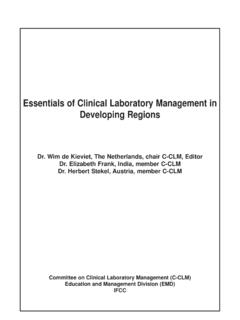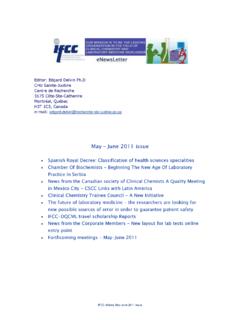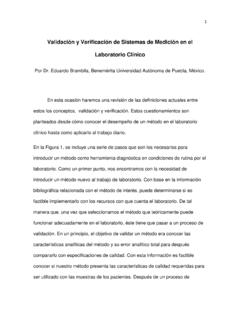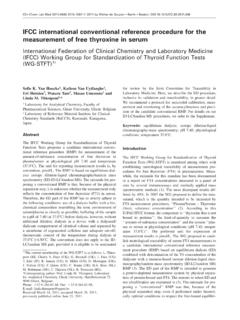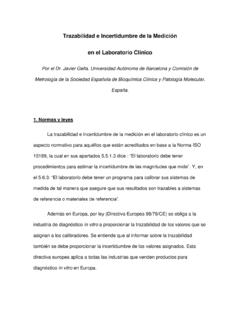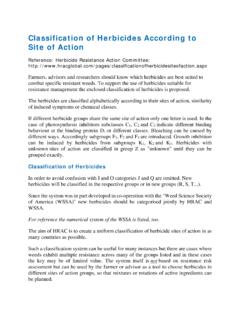Transcription of 1. PATHOPHYSIOLOGY AND CLASSIFICATION OF …
1 M. Sabljar Matovinovi PATHOPHYSIOLOGY and CLASSIFICATION of kidney disease How to Cite this article: PATHOPHYSIOLOGY and Classificatrion of kidney Diseases - eJIFCC 20/01 2009. 1. PATHOPHYSIOLOGY AND CLASSIFICATION OF kidney . DISEASES. Mirjana Sabljar Matovinovi . CLASSIFICATION of CKD. Chronic kidney disease (CKD) is far more prevalent worldwide than was previously assumed. It affects 10 - 15% of the adult population in the western countries, many of whom require costly treatments or renal replacement therapy. According to the Third National Health and Nutrition Examination Survey and the National kidney Foundation kidney Disease report nearly 26 million persons in the USA fall into this category and another 20 millions are at an increased risk for CKD.
2 Moreover, it has been recognized that CKD is a major risk factor for increased cardiovascular disease and death. This knowledge has been incorporated in the recent cardiologic guidelines as well as in the 2007 European Guidelines for the Management of Arterial Hypertension. At the same time, there is an increasing prevalence of diseases that predispose individuals to CKD, such as hypertension, diabetes, obesity and other, rendering the prevention and early detection of CKD a health-care priority in both developed and developing countries. In 2002 the kidney Disease Outcomes Quality Initiative (K/DOQI) of the National kidney Foundation has published guidelines to define CKD and to classify stages in its progression.
3 This CLASSIFICATION system is based on the level of kidney function as estimated by glomerular filtration rate (GFR) regardless of the underlying pathology. Subsequent interventional guidelines, specific to each of these stages, have been published on dyslipidemia, bone mineral metabolism and disease, and blood pressure. In 2004 the international organization kidney Disease: Improving Global Outcomes (KDIGO), governed by an international board of directors, was formed to address the worldwide epidemic of CKD by facilitating the development and implementation of the guidelines with a stated mission to "improve the care and outcomes of kidney disease patients worldwide through promoting coordination, collaboration and integration of initiatives to develop and implement clinical practice guidelines".
4 KDIGO held the first conference in Amsterdam in November 2004. The recommendations from the conference were ratified by the KDIGO board of directors in Paris in December 2004 offering, as a position statement, a clearer definition of CKD and its CLASSIFICATION (Tables and ) and practical advice on its screening and management. 1. M. Sabljar Matovinovi PATHOPHYSIOLOGY and CLASSIFICATION of kidney disease Table Criteria for the definition of chronic kidney disease (CKD). kidney damage for 3 months, as defined by structural or functional abnormalities of the kidney , with or without decreased GFR, that can lead to decreased GFR, manifest by either: Pathologic abnormalities; or Markers of kidney damage, including abnormalities in the composition of the blood or urine, or abnormalities in imaging tests GFR < 60 mL/ m2 for 3 months, with or without kidney damage Table Definition and CLASSIFICATION of chronic kidney disease.
5 kidney Disease: Improving Global Outcomes (KDIGO). kidney Int 2005;67:2089. CLASSIFICATION by severity Stage Description GFR Related terms CLASSIFICATION by treatment ml/ 1. kidney damage albuminuria, proteinuria, with normal or 90 hematuria GFR. 2. kidney damage 60 89 albuminuria, proteinuria, with mild GFR hematuria 3. Moderate GFR 30 59 chronic renal insufficiency, early renal T if kidney transplant, insufficiency recipient 4. Severe GFR 15 29 chronic renal insufficiency, late renal insufficiency, pre-ESRD. 5. kidney failure < 15 (or renal failure, ureamia, end- dialysis) stage, renal disease D if dialysis (hemodialysis, peritoneal dialysis). Treatment by dialysis or transplantation was added in this K/DOQI modified CLASSIFICATION .
6 According to Levey, this was deemed necessary to link with clinical care and policy, especially regarding reimbursement. The T was added for all kidney transplant recipient at any level of GFR (CKD stages 1-5) and D for dialysis for CKD stage 5. Irrespective of the level of GFR at which the dialysis was initiated, all patients treated with dialysis were designated as CKD stage 5D. To improve the CLASSIFICATION the need for elucidation of the cause of CKD as well as the prognosis was expressed. In line with these considerations, a growing body of literature is questioning the appropriateness of grouping all patients with similar GFR in the same CKD stage, given the considerable heterogeneity in the CKD population.
7 Studies by Menon, O, Hare and their coworkers have shown that outcomes in the same CKD stage can 2. M. Sabljar Matovinovi PATHOPHYSIOLOGY and CLASSIFICATION of kidney disease vary considerably depending on age, background cardiovascular risk, etiology and the rate of CKD progression. There are claims that staging system needs to be modified to reflect the severity and complications of CKD in order to allow identification and treatment of clinically relevant disease and avoidance of what seem exaggerated prevalence estimates. These considerations will probably be taken into account by the next K/DOQI Clinical Practice Guidelines for CKD. PATHOPHYSIOLOGY of kidney disease When discussing the PATHOPHYSIOLOGY of CKD, renal structural and physiological characteristics, as well as the principles of renal tissue injury and repair should be taken into consideration.
8 Firstly, the rate of renal blood flow of approximately 400 ml/100g of tissue per minute is much greater than that observed in other well perfused vascular beds such as heart, liver and brain. As a consequence, renal tissue might be exposed to a significant quantity of any potentially harmful circulating agents or substances. Secondly, glomerular filtration is dependent on rather high intra- and transglomerular pressure (even under physiologic conditions), rendering the glomerular capillaries vulnerable to hemodynamic injury, in contrast to other capillary beds. In line with this, Brenner and coworkers identified glomerular hypertension and hyperfiltration as major contributors to the progression of chronic renal disease.
9 Thirdly, glomerular filtration membrane has negatively charged molecules which serve as a barrier retarding anionic macromolecules. With disruption in this electrostatic barrier, as is the case in many forms of glomerular injury, plasma protein gains access to the glomerular filtrate. Fourthly, the sequential organization of nephron's microvasculature (glomerular convolute and the peritubular capillary network) and the downstream position of the tubuli with respect to glomeruli, not only maintains the glomerulo-tubular balance but also facilitates the spreading of glomerular injury to tubulointerstitial compartment in disease, exposing tubular epithelial cells to abnormal ultrafiltrate. As peritubular vasculature underlies glomerular circulation, some mediators of glomerular inflammatory reaction may overflow into the peritubular circulation contributing to the interstitial inflammatory reaction frequently recorded in glomerular disease.
10 Moreover, any decrease in preglomerular or glomerular perfusion leads to decrease in peritubular blood flow, which, depending on the degree of hypoxia, entails tubulointerstitial injury and tissue remodeling. Thus, the concept of the nephron as a functional unit applies not only to renal physiology, but also to the PATHOPHYSIOLOGY of renal diseases. In the fifth place, the glomerulus itself should also be regarded as a functional unit with each of its individual constituents, endothothelial, mesangial, visceral and parietal epithelial cells - podocytes, and their extracellular matrix representing an integral part of the normal function. Damage to one will in part affect the other through different mechanisms, direct cell-cell connections ( , gap junctions), soluble mediators such as chemokines, cytokines, growth factors, and changes in matrix and basement membrane composition.


